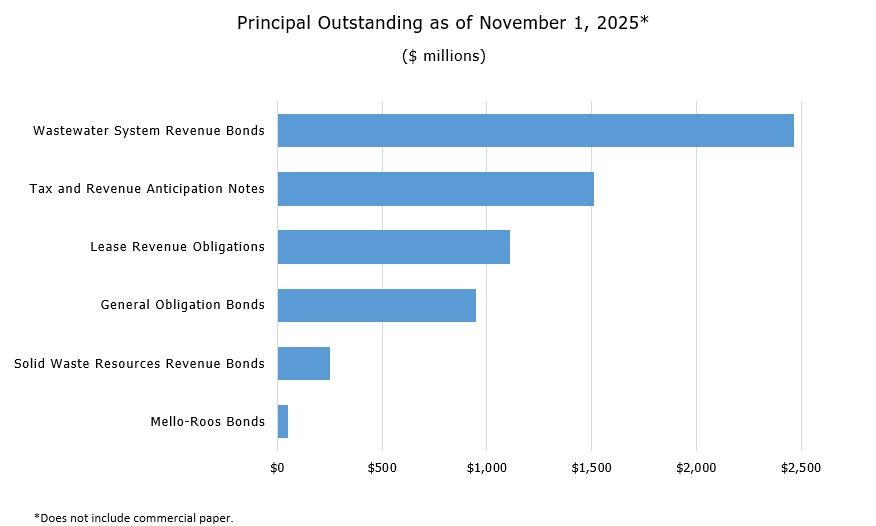Matthew W. Szabo, City Administrative Officer
City of Los Angeles
City of Los Angeles
Learn about the City of Los Angeles, including the City's debt programs and the Office of the City Administrative Officer.
Have questions? Reach out to us directly.
Learn about the City of Los Angeles, including the City's debt programs and the Office of the City Administrative Officer.
The City of Los Angeles is the second most populous city in the United States, with an estimated 2025 population of 3.8 million. Founded in 1781, Los Angeles is the principal city of a metropolitan region stretching from the City of Ventura to the north, the City of San Clemente to the south, the City of San Bernardino to the east, and the Pacific Ocean to the west. The City’s 470 square miles contain 11.5 percent of the area of the County of Los Angeles, California (the “County”) and approximately 39 percent of the population of the County.
Tourism and hospitality, professional and business services, direct international trade, entertainment (including motion picture, television and digital media production), and wholesale trade and logistics all contribute significantly to local employment. Emerging industries are largely technology driven, and include biomedical technology, digital information technology, environmental technology and aerospace. As home to the film, television and recording industries, as well as important cultural facilities, the City serves as a principal global cultural center.

Please see below for a summary of the debt programs managed by the CAO.
Los Angeles Wastewater (LAWW) System Revenue Bonds and Wastewater Commercial Paper Notes are used to finance capital improvements related to the City’s wastewater system (Wastewater System). The Wastewater System serves an approximately 600 square mile area with a population in excess of 4.5 million or approximately 45% of the population of Los Angeles County. The Wastewater System has two distinct services areas: the Hyperion service area and Terminal Island service area. In addition to serving most of the City, the System also provides wastewater conveyance, treatment, and disposal services to 29 entities, including sanitation districts, cities, governmental entities, and private businesses which adjoin the City. The Wastewater System consists of more than 6,800 miles of mainline sewers, four water reclamation plants, and various other facilities. As of November 1, 2025, there is $2.47 billion in outstanding LAWW System Revenue Bonds. In addition to long-term debt, the City has a Wastewater System Commercial Paper Notes Program of up to $400 million.
The City annually issues tax and revenue anticipation notes (“TRANs”) to alleviate short-term cash flow needs that occur early in the fiscal year when taxes and revenues have not yet been received. A large portion of these cash flow needs arise from the City’s long-standing practice of paying its contribution to its pension systems early in the fiscal year to receive a discount. As of November 1, 2025, there is $1.51 billion in outstanding TRANs.
Since the creation of the Municipal Improvement Corporation of Los Angeles (MICLA), a nonprofit public benefit corporation, in 1984, the City has entered into lease financings with MICLA for certificates of participation, lease revenue bonds or similar financial instruments. As of November 1, 2025, there is $1.11 billion in long-term outstanding lease revenue obligations. In addition to long-term debt, the City has two MICLA Commercial Paper (CP) Programs totaling up to $525 million. Debt issuances under this program have been used for the acquisition and improvement of real property and capital equipment.
Between 1989 and 2016, City voters approved the issuance of General Obligation (GO) Bonds totaling over $3.7 billion for various City projects, such as for libraries, police, fire safety, seismic safety, zoo, animal shelters, emergency operations, storm water, and homeless housing. As of November 1, 2025, there is $950 million in outstanding GO Bonds. Further, there is $60.5 million of unused GO Bond authorization for storm water projects pursuant to Proposition O and $86.0 million of unused GO Bond authorization for homeless housing and facilities projects pursuant to Proposition HHH as of November 1, 2025. The voters may approve additional GO Bonds in the future.
Solid Waste Resources (SWR) Revenue Bonds are issued to finance the acquisition and improvement of certain real property and capital equipment for the City’s solid waste collection and disposal system (Solid Waste System). The Solid Waste System provides solid waste collection services to approximately 743,000 households within six collection districts. The 743,000 households serviced by the Solid Waste System generally represent single family dwellings, duplexes and multi-family dwellings of four units or less. As of November 1, 2025, there is $253 million in outstanding SWR Revenue Bonds.
The Land-Secured Mello-Roos Special Tax Financing Program predominantly encompasses Mello-Roos (or Community Facilities Districts (CFD)) financings. The City periodically receives requests to create CFDs or other special districts for various types of infrastructure improvements. Bonds payable from special taxes within the CFD would be issued to finance such improvements. As of November 1, 2025, the City has CFD special tax bonds outstanding for the following CFDs: City of Los Angeles Community Facilities District No. 4 (Playa Vista-Phase I), City of Los Angeles Community Facilities District No. 8 (Legends at Cascades), and City of Los Angeles Community Facilities District No. 11 (Ponte Vista). There is $52.1 million in outstanding CFD special tax bonds as of November 1, 2025. In 2013, the City formed Community Facilities District No. 9 for the Downtown Streetcar. The City has not issued bonds for the project.
The Parking System Revenue Bonds are paid from revenues collected from on-street and off-street meters and parking lots owned and operated by the Los Angeles Department of Transportation. In Fiscal Year 2013-14, the City redeemed all outstanding bonds totaling $80.9 million with lease revenue commercial paper notes. While there are no immediate plans to issue additional bonds, the City may do so in the future.
From time to time, the City has issued judgment obligation bonds to finance larger judgments or settlements, as it did in Fiscal Years 2008-09 and 2009-10. As of November 1, 2025, there are no judgment obligation bonds outstanding. The City may issue judgment obligation bonds in the future.
In the past, the City has issued special tax and assessment supported debt. The City currently does not have any bonds outstanding in its Special Tax or Assessment District Financing Program, it has previously issued MICLA Special Tax Lease Revenue Bonds (Police Emergency Command Control Communications System) and Landscaping and Lighting District 96-1 Assessment Bonds.
From time to time, the City may engage in other types of financing transactions such as public private partnerships (P3) and Pension Obligation Bonds.
Three departments that are under the control of Boards appointed by the Mayor and confirmed by the Council, namely the Los Angeles Department of Water and Power, Los Angeles World Airports, and the Port of Los Angeles, directly manage their own bond programs. Further, the Los Angeles Housing Department directly manages housing bonds for qualified developments located in the City of Los Angeles.

The City Administrative Officer (CAO) provides internal and centralized services to the Mayor, City Council, and City departments. The CAO is the financial advisor to the Mayor and City Council and is the only appointed City officer to report both to the Mayor and City Council. The mission of the CAO is to provide sound advice and recommendations to the Mayor and Council on the fiscal condition, financial status, and future needs of the City and to promote productivity, economy, and efficiency in the conduct of City government so that available resources provide the greatest benefit possible to the residents of the City of Los Angeles.
The CAO assists the Mayor and Council in the preparation of the City budget, plans and directs the administration of the budget, and directs the development of work programs and standards. The CAO represents the management of the City in negotiating all labor contracts. In addition, the CAO provides revenue estimating and long term financial planning, debt issuance and administration, and risk management services Citywide.
The primary work activities of the CAO include:
Have questions? Reach out to us directly.